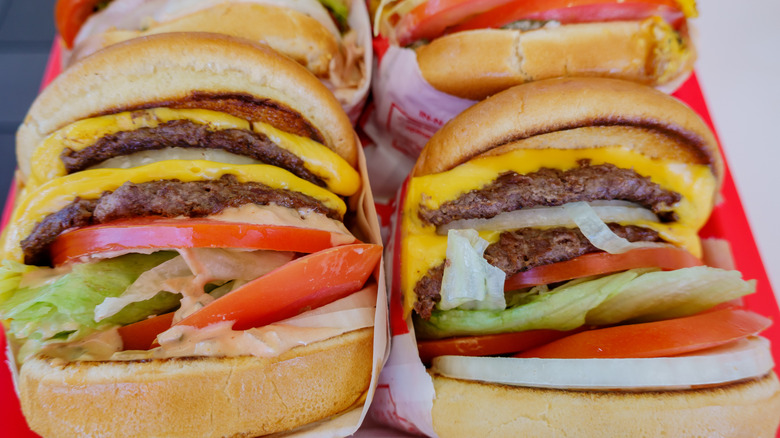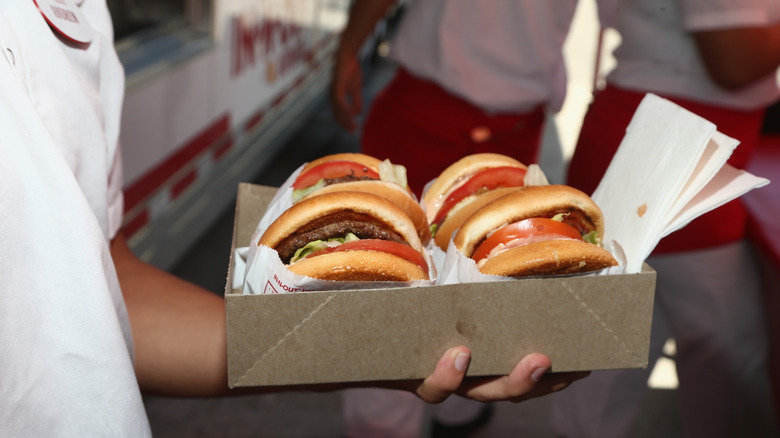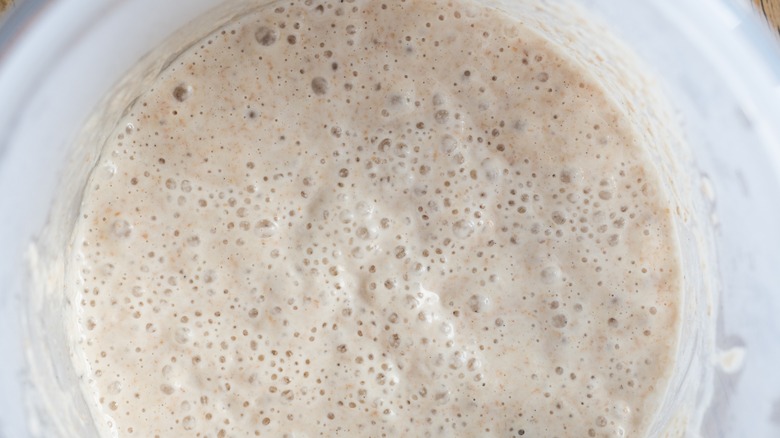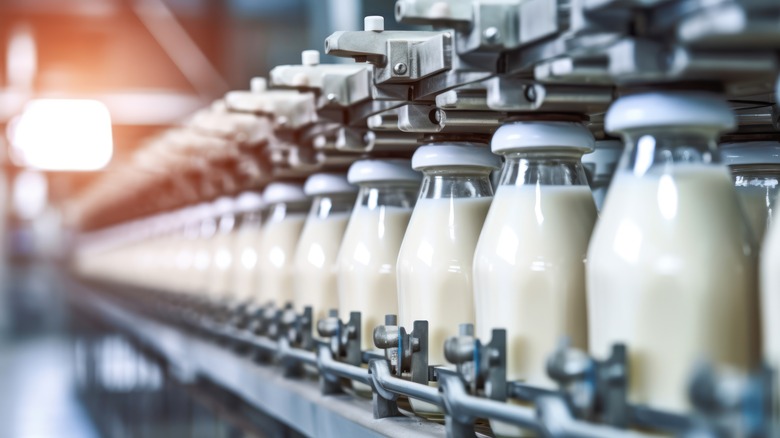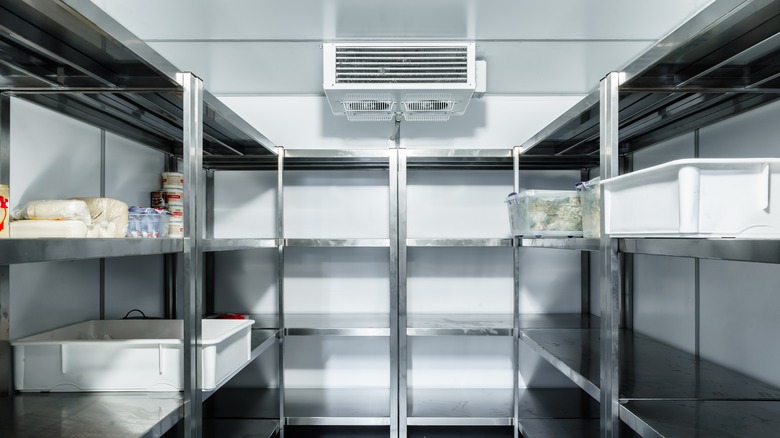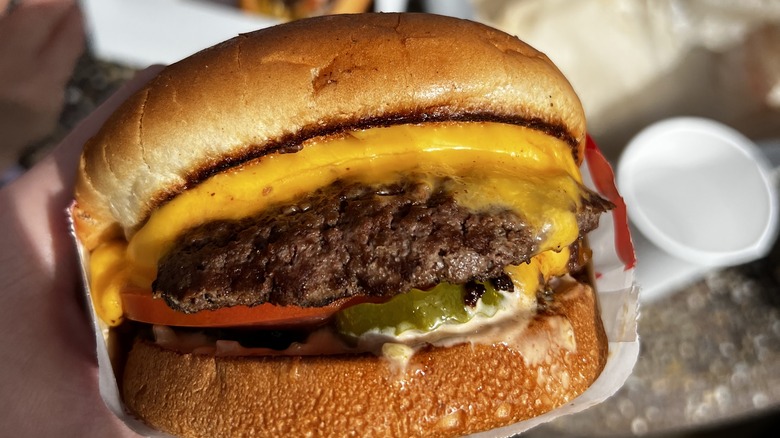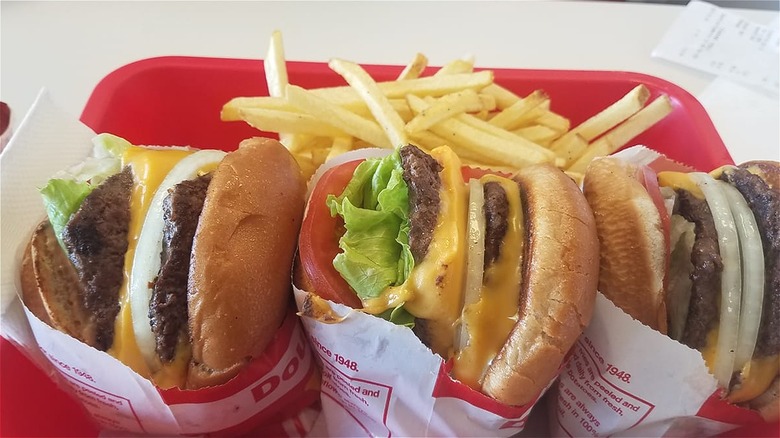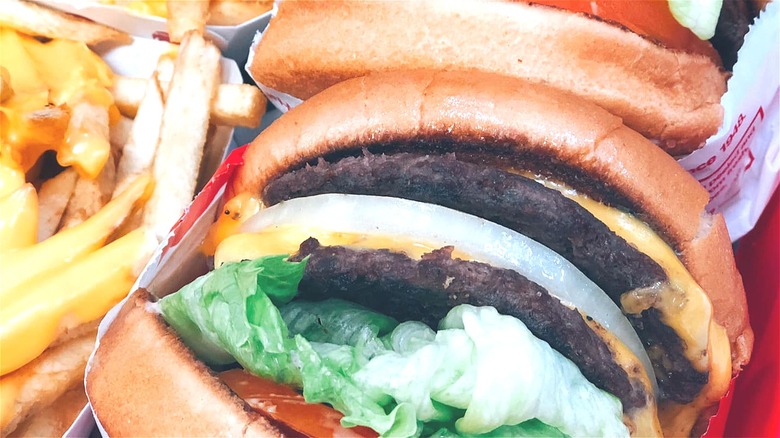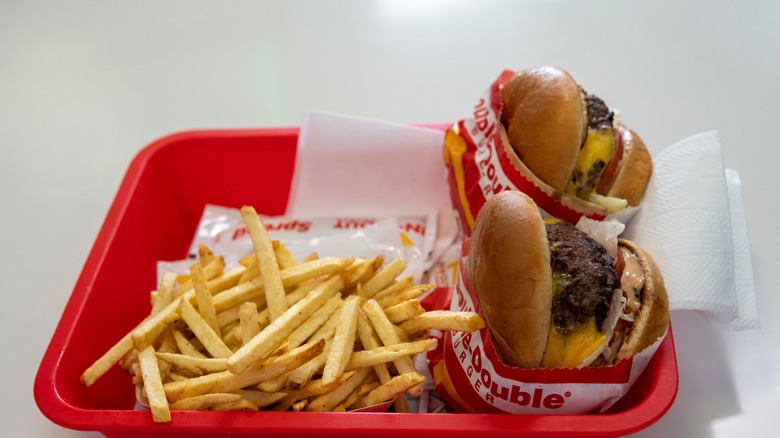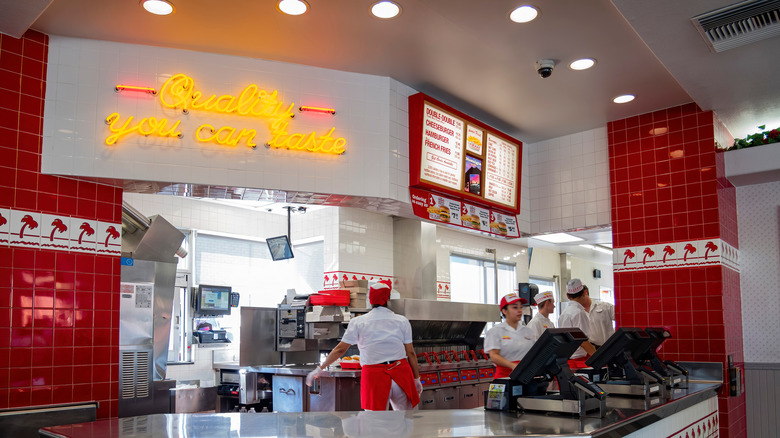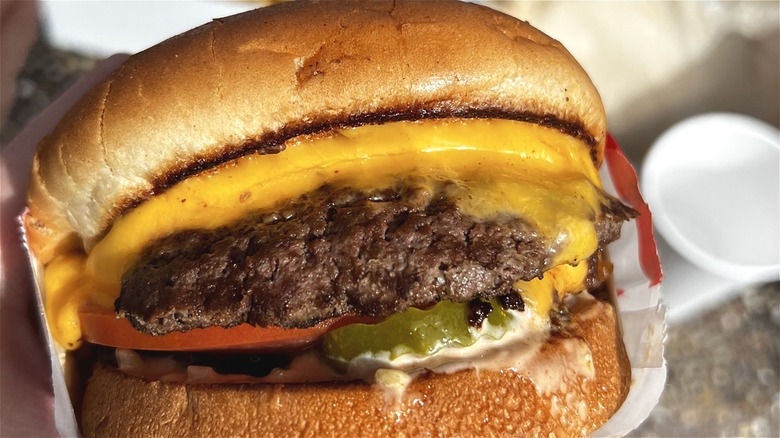How Do In-N-Out Burger Buns Differ From Other Chains'?
Debate all you want, but In-N-Out commonly satisfies the national appetite for top-tier hamburgers. It's a statistically proven fact that when push comes to shove, the California burger joint knows what it's doing. We've found devotees usually praise what's tucked inside the buns. The zip of secret sauce. The beef patties glued together by golden blankets of cheese. But the bun, holding those glorious contents together? That part tends to get way, way overlooked.
Those not under the spell of the yellow arrow — most of the U.S. population really, due to the chain's limited geography — might question how In-N-Out Burger's buns differ from other fast food chains. And while that's a fair point, it ignores the painstaking effort the West Coast institution puts into what's considered the foundation of its flagship product. A Mashed poll from December 2022 may have seen Chick-fil-A's buns come out on top, but between the scrupulously crafted recipe and freshly-baked quality, one should have no reservations about In-N-Out's toasted-to-perfection buns. Let's view how In-N-Out's buns are made before taking a look at how other franchises are doing it. Believe us, the difference is night and day.
In-N-Out Burger has never tweaked the recipe
Other than switching to hormone-free beef and the occasional menu item launch, In-N-Out's food has remained virtually unchanged from how fry cooks prepared it over 70 years ago. "Times may change, but our values endure," is the brand's motto, after all, and in our view, the bun feels like a proper symbol of this unshakeable commitment to good quality. Compared to McDonald's, which can be found tweaking its recipe periodically, the recipe In-N-Out's safe-guarded for decades has stayed intact.
Puritan Bakery, the supplier who makes the restaurant's buns, is a small bakery outlet that's resided in Southern Los Angeles since the late 1930s. The wholesaler began supplying the fast food restaurant with its rolls dating back to the 1950s, and from there, the chain never stopped using them. For context, In-N-Out Burger opened its Baldwin Park flagship in 1948, leaving only a couple of years before the supplier entered the picture. It doesn't exactly seem like a stretch to say the factory was basically involved at the beginning of the business.
John Markulis, the supplier's late owner who joined the bakery in the 1960s, remarked, "With a hamburger, the first thing you taste is the bun" (via the Los Angeles Times). A philosophy like that has served In-N-Out well, and without debate, distinguishes the California company from its competitors.
The buns are baked using an old-school process
The way In-N-Out's buns are baked leans on a technique that's undoubtedly the antithesis of modern-day fast food. How so? Puritan Bakery relies on an old-school technique that, in fast food, has gone the way of the dodo bird: the sponge and dough method.
You make the sponge by mixing a small portion of the water, flour, and yeast together and fermenting the concoction until it forms into a billowy blob. Typically, this portion of the work can take up to as many as eight hours, and Puritan Bakery claims to let its doughs rise for around seven — making it far from the speedy process that defines mass-produced buns. Once the gluten's activated enough, the gloop is finally tossed with the remaining components that eventually form the buns.
Of course, not rushing the process creates the delectable taste and texture we notice when eating In-N-Out's burger buns. Soft and slightly tender, the crumb is still sturdy and can withstand the weight of multiple beef patties smothered in spread.
In-N-Out buns are dairy-free
Milk is practically unrivaled for its baking properties, adding moisture and amping up the fluffiness quotient of sweet treats like cakes, muffins, and of course, bread. Would anyone biting into an Animal-Style sandwich ever guess the bun lacked that ingredient? Well, it's true — although the chain and its faithful supplier are notoriously mum on dropping their secrets, the sponge dough behind those prized burger buns is made with wheat, yeast, and water — no milk. Because of this fact, the drive-thru icon could be one of the better spots for lactose-intolerant diners, since visitors would mainly have to steer clear of the shakes and cheese.
There are definitely companies in the fast food world that hawk burger buns with milk, and there are more of them than we'd assume. The first that comes to mind? How about Five Guys. The Virginia-based chain confirmed on social media that its buns include milk and eggs out of a total of nine components. Martin's potato rolls, the bun of choice for Shake Shack, also lists nonfat milk on the nutrition label.
In-N-Out doesn't freeze its burger buns
From the get-go, In-N-Out has never frozen its hamburger meat. It's one of many reasons the In-N-Out's burgers are so delicious, and in an industry overrun by flash-freezing and heat lamps, impeccably fresh. In fact, the company's built this focus on freshness into its business model. Potential restaurants have to reside within a 300-mile radius of a warehouse in order for perishable goods to arrive fresh at the chain's shops. As a rule, In-N-Out restaurants don't even contain freezers, so it's safe to say the buns aren't frozen.
By contrast, employees on Reddit confirm that some Wendy's locations are guilty of freezing their buns. An incident involving the Golden Arches points to bun-freezing as a standard industry practice. In December 2017, a Hawaii-based McDonald's was impacted by a bakery wholesaler's sudden closure. The restaurant, acting quickly to make up for the shortage, was able to obtain more supplies from a different factory, and had frozen buns shipped to its doorstep. The location's manager explained that removing preservatives required McDoald's to freeze all of its buns, no matter where they're baked. Bakery-tier rolls at a neighborhood Mickie D's just isn't a realistic expectation.
Buns from In-N-Out are intended to be toasted
Toasting buns hasn't always been the norm, yet we've witnessed dining chains for a while adopting this extra elevating touch, including Wendy's and Church's Chicken. Of course, In-N-Out was doing it before it was popular, but on the bun front, there's a distinguishing element that separates the fast food icon from its peers by a fairly wide margin. It turns out that In-N-Out's burger buns are actually intended to create a good toast, due to the custom recipe concocted by Puritan Bakery many moons ago.
Predictably, the bakery wholesaler won't spill the secret sauce on how it's done, but the internet is rife with inquisitive foodies who have been able to reach some intriguing possibilities anyway. For instance, one Reddit commenter responding to a post seeking cooking advice concluded that the key to recreating In-N-Out's trademark toasting style was granulated sugar. The reason? They speculated that, compared to the commonly-used corn syrup found in rolls on the supermarket shelf, standard table sugar helps the bread develop the golden, brittle surface and excellent crunch we all love. McDonald's can try all it likes to gussy up its buns on the grill, but it'll still be a world apart from the carefully engineered sponge dough from In-N-Out.
Patented technology achieves the buns' trademark toast
Patented technology ... for toasting a bun? Yep, you read that right. In-N-Out might not be the first burger joint to have conceived of slapping buns on a hot stovetop, but it does toast them with equipment that's inaccessible to competing forces. Talk about going above and beyond the usual fast food chain. The kitchen tool employees use for every burger on the line belongs to the company, and when doing a little digging, a patent the brand filed in August 2019 turns up the proprietary technique in its full form. Sure enough, no ordinary toasting tool will darken the edges of any Animal Style burger churning down the line.
Of course, the main gist behind this invention doesn't exactly describe anything unusual, so far as the specifics go. The summary, to start, describes a "toasting apparatus for improving heat transfers on griddles" which to even a layman's ears resembles basically any cooking contraption you'd see in a modern restaurant kitchen. Even setting aside such a basic culinary concept (i.e. toasting), we're aware that In-N-Out maintains a secretive image. That there are exclusive gadgets for something as simple as toasting buns further proves an allure its adversaries don't have.
The buns aren't buttered when toasted
Ahh, bread and butter. A duo that goes hand-in-hand like peanut butter and jelly or cheese and crackers. Besides infusing flavor, buttering hamburger buns before grilling them leads to stronger browning. Though it's seemingly no longer on the menu, Wendy's offered a buttered bun once upon a time with the Dave's Hot 'n Juicy Cheeseburger, but many chains do it as the default — think of the prized ButterBurgers sold by Culver's. In-N-Out flouts convention here, and witholds the greasy butter pat altogether.
Forgoing the spread does have its upsides, even though skeptics might argue that the savory boost would play well with the patty and its plentiful fixings. Recall how the sponge dough doesn't contain any milk. By leaving out the butter, dairy-free customers won't have to worry about hidden contaminants. Toasting the bun bare also maintains the bun's springy feel and airy texture. Butter could create more grease that weighs down the bread, and with beef patties contributing most of that mess already, In-N-Out may be wise to keep things plain.
All In-N-Out burgers feature the same buns
Just when you thought toppings and sauce were the limit for fast food hamburgers, chains have really run amok by offering buns more reminiscent of a pastry shop. Wendy's Pretzel Bacon Pub Burger or Jack in the Box's Bacon & Swiss Buttery Jack (showcasing a honeyed brioche roll) are just the tip of the iceberg. When restaurants opt out of the trend and stick to the classic white bun, it's notable. In-N-Out very much lies in this camp. Having established its "never change" mentality, every sandwich comes on the same grilled bun, short of those who venture off the beaten path by ordering a bun-less bite from the In-N-Out Secret Menu. Rejecting gimmicks and whatever new trend that's taken over TikTok is sort of the chain's thing. Why fix something that isn't broken?
The bun-free items we just cited are quite popular among ardent followers of the drive-thru chain, not to mention good news for gluten-free eaters. The Flying Dutchman, for example, is a plain double cheeseburger minus the starch, while going Protein Style cradles all the fixings in a fresh lettuce wrap. Other than that, ordering a traditional hamburger or cheeseburger on your drive-thru run is a straightforward affair. No sourdough or challah loaves lurk here — just the same fresh sponge dough bun generations have gobbled down.
Stores have closed if the buns aren't up to snuff
Soggy, deflated hamburger buns: It's a tale as old as the invention of the pick-up window, a standard weeknight feature for any franchise with an "Open" sign on the door. But the more we realize how seriously In-N-Out takes quality control, the more we understand how a crummy bun isn't just fodder for the trash bin — it's a mistake that's serious enough to lose profits. Take what occurred in the summer of 2018, when, without warning, the company shut down all of its Texas restaurants for about two days due to a bad batch of buns.
The culprit, thankfully, was nothing alarming — no E. coli outbreak, for instance – but the company was adamant on halting service regardless. Per Nation's Restaurant News, the bread rolls "did not meet the quality standards" and therefore the company couldn't keep stores chugging along as usual. Eventually, the supply chain delivered quality buns, and within 48 hours, all 37 of the impacted restaurants were open again. Still, outlets were left wondering why such extreme measures were taken in the first place, and The Dallas Morning News approached some employees for comment on the matter. The culprit? An off-smell.
The buns don't contain artificial preservatives
Processed foods, by their nature, contain some less-than-natural ingredients. However, In-N-Out Burger keeps preservatives out of the picture altogether. This purity is unprecedented and has arguably spurred rival franchises to overhaul additive-laced menu items in the hopes of competing. A clip of TV presenter Huell Howser touring a location showed an employee emphasizing the lack of "shelf life" for In-N-Out's buns, and in this case, that's a point of pride for the chain, not a pitfall.
To date, the trend of eateries "cleaning up" food lineups has resulted in some surprisingly sweeping changes. In 2018, McDonald's cleansed its burger buns of calcium propionate, a stabilizer that shows up in most wheat products, such as desserts and bread. Yet that doesn't necessarily mean all fast food chains are in the clear. Jack in the Box and McDonald's still utilize preservatives in some of their offerings.
